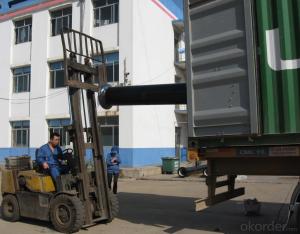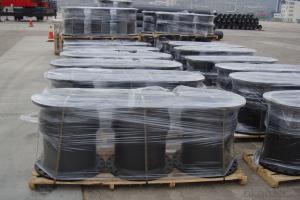DUCTILE IRON PIPES C Class DN1000
- Loading Port:
- China Main Port
- Payment Terms:
- TT OR LC
- Min Order Qty:
- -
- Supply Capability:
- -
OKorder Service Pledge
OKorder Financial Service
You Might Also Like
Ductile Iron Cast Pipe is without any defects compare with tradition casting tech, which has many advantages particularly as follow:
(1) High density. In the "vertical upward casting" process, the melt iron of centre liquid column in center crystallizer is continuously feeding for volume shrinkage caused by condensation tube at outer circumference , which lead to be free of shrinkage porosity.
(2) High purity. When melt iron pouring, the mixed impurities such as gas, dross, sand grain which are lighter than melt iron could be eliminated at furnace mouth, its impossible to enter into the crystallizer through the channel, so the melt iron into the crystallizer is very pure.
(3) Strength with toughness. The cooling speed provided by continuous crystallizer is 30 times than sand casting and 5 times than centrifugal casting, and doesn't produce white iron, the eutectic cell volume of continuous cast iron is one eighth to one tenth compare with traditional cast iron. The density of graphite nodule in ductile iron can reach 300-700 pcs/mm2. Therefore, all reason above improve the strength and toughness of continuous cast iron.
(4) Free machining. The high speed cooling make the hardening phase (such as boride, steadite) not appear like reticular, massive or thick, but diffuse like fish bone and pane in shape, moreover, there are tiny graphite flakes inlaid hardening phase. It's free machining in BrinellHardness the range of 250-300HB. However, the Brinell Hardness of 250 is top limit to common metal materials.
(5) Uniform composition of tube wall. The convection mixing of liquid column caused by marching type drawing in crystallizer make the composition of tube wall well-distributed, and concentration gradient very little.
(6) High productivity. To the wall thickness of tube under 10mm, the speed of continuous casting is 1 meter/min, to the wall thickness of tube under 20mm, the speed of continuous casting is 0.5 meter/min, which is high efficiency that centrifugal or other casting tech couldn't reach.
- Q:What is the cost of ductile iron pipe compared to other pipe materials?
- The cost of ductile iron pipe compared to other pipe materials can vary depending on various factors such as the size, length, and specific requirements of the project. However, generally speaking, ductile iron pipe tends to be more expensive than some of the alternative pipe materials such as PVC or HDPE (high-density polyethylene) pipes. Ductile iron pipe is known for its exceptional strength and durability, making it suitable for a wide range of applications including water distribution, wastewater systems, and industrial piping. Its robustness and longevity contribute to its higher cost compared to other pipe materials. On the other hand, PVC and HDPE pipes are often more affordable options due to their lower production and material costs. Additionally, these materials are lightweight, easy to install, and resistant to corrosion, which can lead to cost savings during installation and maintenance. It is important to note that while ductile iron pipe may have a higher upfront cost, its superior strength and longevity can result in long-term cost savings by minimizing the need for frequent repairs or replacements. The choice of pipe material should be made considering the specific project requirements, budget constraints, and the anticipated lifespan of the infrastructure.
- Q:Can ductile iron pipes be used for underground storage of hazardous materials?
- No, ductile iron pipes are not recommended for underground storage of hazardous materials due to potential corrosion issues and the risk of leaks or contamination.
- Q:Can ductile iron pipes be used for trench crossings?
- Yes, ductile iron pipes can be used for trench crossings. Ductile iron pipes are known for their high strength and durability, making them suitable for various applications including trench crossings. They have the ability to withstand heavy loads and provide increased resistance to external forces, making them a reliable choice for such purposes.
- Q:Can ductile iron pipes be used for trenchless installation methods?
- Yes, ductile iron pipes can be used for trenchless installation methods. Trenchless installation methods are techniques used to install underground pipes without the need for extensive digging or trenching. Ductile iron pipes are a strong and durable choice for these methods due to their high tensile strength and flexibility. They can be installed using various trenchless techniques such as horizontal directional drilling (HDD), pipe bursting, and slip lining. These methods allow for efficient and cost-effective installation of ductile iron pipes without disrupting the surrounding environment. Additionally, the corrosion resistance of ductile iron pipes makes them suitable for trenchless installations in various soil conditions and environments.
- Q:If the ductile iron pipe is broken, can we use rush repair?
- PE pipe repair section, as the name suggests, is a kind of used to repair the pipeline accessories. At present, the specifications of the repair section are: Phi 90, Phi 110, Phi 125, Phi 160, Phi 200, Phi 225, Phi 250, Phi 315 these specifications.
- Q:What is the expected leakage rate of ductile iron pipes?
- The expected leakage rate of ductile iron pipes can vary depending on various factors such as the age, condition, and installation quality of the pipes. However, on average, ductile iron pipes are known to have a relatively low leakage rate, typically ranging from 0.1 to 0.5 gallons per minute per mile of pipe.
- Q:What are the different methods for tapping ductile iron pipe?
- Tapping ductile iron pipe can be done in several different ways, depending on the project's specific needs. Some commonly used methods include: 1. Mechanical Tapping: To create a hole in the ductile iron pipe, a mechanical tapping machine is employed. Equipped with a rotating cutting tool, the machine easily cuts through the pipe wall, resulting in a clean hole. This method is ideal for smaller diameter pipes and is both quick and efficient. 2. Hot Tapping: While the ductile iron pipe is still in service and under pressure, hot tapping involves creating a hole. To ensure safety and maintain the pipe's integrity, specialized equipment and expertise are required. Hot tapping is commonly used when shutting down the pipeline for maintenance or repair work is impractical or not feasible. 3. Electrofusion Tapping: For larger diameter pipes, electrofusion tapping is a suitable method. It involves using an electrofusion saddle and fitting to create a branch connection on the ductile iron pipe. By welding a fitting onto the pipe with an electrofusion machine, a secure and leak-proof connection is achieved. This method can be used for both water and gas applications. 4. Saddle Tapping: A cost-effective and simple method for smaller diameter pipes is saddle tapping. It involves attaching a saddle or clamp onto the ductile iron pipe and drilling a hole through it. The saddle is then equipped with a threaded outlet to connect a branch line. 5. Split Sleeve Tapping: For larger diameter pipes, split sleeve tapping is commonly used. This method requires cutting a section out of the ductile iron pipe and installing a split sleeve over the cut. By bolting the split sleeve together, a secure and watertight connection is established. It is suitable for both water and gas applications. When selecting the tapping method, it is crucial to consider factors like pipe size, pressure rating, required branch connection, and project-specific requirements. Consulting a professional engineer or tapping specialist is highly recommended to ensure the correct method is used for tapping ductile iron pipe.
- Q:Can ductile iron pipes be used in high-pressure applications?
- Yes, ductile iron pipes can be used in high-pressure applications. Ductile iron pipes are known for their strength and durability, making them suitable for handling high-pressure fluids or gases. They have a higher pressure rating compared to other types of pipes, such as PVC or HDPE pipes. Ductile iron pipes also have excellent resistance to external loads and are capable of withstanding high internal pressures. These pipes are commonly used in water and wastewater systems, as well as in industrial applications where high-pressure conditions are present. It is important, however, to ensure that the ductile iron pipes used in high-pressure applications meet the required standards and specifications to ensure their safe and reliable operation.
- Q:What are the different types of joints used in ductile iron pipes?
- There are several types of joints commonly used in ductile iron pipes. These joints are designed to provide a secure and leak-proof connection between pipe sections. Here are some of the most commonly used joint types: 1. Push-on joint: This type of joint is easy to install and requires no special tools. It involves lubricating the gasket on one end of the pipe and pushing it into the socket of the adjoining pipe. The gasket creates a tight seal that prevents leakage. 2. Mechanical joint: This joint type consists of a gland and a follower gasket. The gland is placed over the spigot end of one pipe, and the follower gasket is inserted into the bell end of the adjoining pipe. The gland is then tightened with bolts and nuts, compressing the gasket to form a secure joint. 3. Restrained joint: This joint is used in applications where pipes need to be restrained against axial movement or pressure thrust. It typically involves a mechanical joint with additional components such as tie rods, thrust blocks, or restrained couplings to provide the necessary restraint. 4. Flanged joint: Flanged joints are commonly used in large diameter ductile iron pipes. They involve a flange on one pipe end and a mating flange on the other pipe end. The two flanges are bolted together, creating a strong and secure connection. Flanged joints allow for easy disassembly and reassembly if needed. 5. Welded joint: Welded joints are created by fusing the ends of two pipes together using heat and pressure. This type of joint provides a permanent and strong connection. Welded joints are commonly used in underground or buried applications where long-term durability is essential. It is important to note that the choice of joint type depends on factors such as pipe diameter, application, and project requirements. Consulting with a professional engineer or the manufacturer's guidelines is recommended to ensure the appropriate joint type is selected for ductile iron pipes.
- Q:How do ductile iron pipes perform in high-velocity water flow conditions?
- Ductile iron pipes perform excellently in high-velocity water flow conditions. Their inherent strength and durability allow them to withstand the force and turbulence of fast-flowing water without any significant issues. These pipes have been extensively tested and proven to maintain structural integrity, resist erosion, and minimize the risk of leaks or bursts, making them a reliable choice for high-velocity water flow applications.
1. Manufacturer Overview |
|
|---|---|
| Location | |
| Year Established | |
| Annual Output Value | |
| Main Markets | |
| Company Certifications | |
2. Manufacturer Certificates |
|
|---|---|
| a) Certification Name | |
| Range | |
| Reference | |
| Validity Period | |
3. Manufacturer Capability |
|
|---|---|
| a)Trade Capacity | |
| Nearest Port | |
| Export Percentage | |
| No.of Employees in Trade Department | |
| Language Spoken: | |
| b)Factory Information | |
| Factory Size: | |
| No. of Production Lines | |
| Contract Manufacturing | |
| Product Price Range | |
Send your message to us
DUCTILE IRON PIPES C Class DN1000
- Loading Port:
- China Main Port
- Payment Terms:
- TT OR LC
- Min Order Qty:
- -
- Supply Capability:
- -
OKorder Service Pledge
OKorder Financial Service
Similar products
New products
Hot products
Related keywords




























